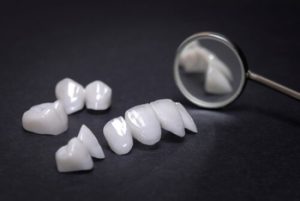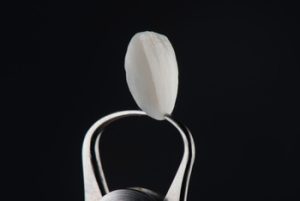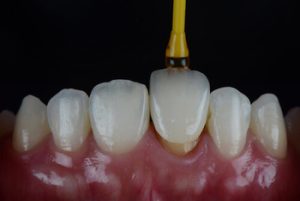Veneers have become a favourable approach for those seeking a transformative smile. If you’re considering this cosmetic dental treatment, you’re probably wondering: How are veneers fitted? Whether dealing with chipped, crooked, or discoloured teeth, veneers offer a natural and comfortable solution. In this blog, we’ll dive deeply into the veneer fitting process, from your initial consultation to enjoying your brand-new smile.
What Are Dental Veneers?
Before discussing how veneers are fitted, let’s define them. Dental veneers are thin layers of material bonded to the front surface of teeth. They are designed to boost the appearance of teeth, giving you a more polished, uniform smile. They can be made from different materials, including porcelain, composite, and resin veneers.
The Types of Veneers
There are several types of veneers, each offering unique benefits:
- Porcelain Veneers: Esteemed for their durability and natural look, they are popular among those looking for long-lasting solutions.
- Composite Veneers: These are crafted from composite resin and offer a less expensive alternative. Composite veneers cost less than porcelain but may require more maintenance.
The Veneer Fitting Process: Step-by-Step
Getting veneers is a multi-step process involving two or more visits to your cosmetic dentist. Let’s walk through the veneer procedure so you can know what to expect.
Initial Consultation and Treatment Plan
 The first step is always an initial consultation. During this visit, your dentist evaluates your oral health and discusses your goals for your smile. This is the time to raise any concerns you have, whether it’s about crooked, discoloured, or misshapen teeth. The dentist will develop a treatment plan tailored to your needs.
The first step is always an initial consultation. During this visit, your dentist evaluates your oral health and discusses your goals for your smile. This is the time to raise any concerns you have, whether it’s about crooked, discoloured, or misshapen teeth. The dentist will develop a treatment plan tailored to your needs.
The dentist will also take X-rays and possibly make an impression on your teeth to assess the state of your natural teeth. This is crucial for planning the tooth preparation and ensuring your veneers fit perfectly.
Tooth Preparation and Temporary Veneers
The next step involves tooth preparation, which removes a small amount of tooth enamel to make space for the veneers. This step is critical for creating a natural look. If you’re getting traditional porcelain veneers, the amount of enamel removed is minimal, but it’s still necessary to ensure the veneers don’t look bulky.
For composite veneers, less tooth preparation is typically required, but the veneers are thin and need a smooth surface to adhere properly. After the preparation, you may receive temporary veneers to shield your teeth while your permanent ones are being made. These temporary veneers are generally less durable but give you an idea of the final result.
Creating Custom Veneers
While you’re wearing temporary veneers, your dentist will send the impressions of your prepared teeth to a dental lab, where your customised veneers will be crafted. This part of the veneer process takes one to two weeks. The veneers are shaped and colour-matched to blend seamlessly with your existing teeth, giving you a natural-looking smile.
The Fitting: Applying Your Veneers
Once your custom porcelain veneers or composite resin veneers are ready, you’ll return to the dental clinic for your second appointment. During this visit, the dentist will first remove the temporary veneers and check the fit of your new ones. The goal is to ensure the veneers sit comfortably on your natural teeth and align perfectly with your entire tooth.
If everything fits well, using dental cement, the next step is to permanently bond the veneers to your teeth. The bonding process involves carefully placing the veneers onto the prepared teeth and then using a special light or ultraviolet light to harden the dental bond.
Shaping and Finishing Touches
Once the veneers are bonded, the dentist will remove any excess cement and ensure that your new veneers are shaped perfectly to your bite. This is important to ensure the veneers look natural and don’t affect your ability to chew or speak.
The final result should feel comfortable and look completely natural. The veneers are thin tooth coverings, so you shouldn’t feel like you’re wearing anything extra on your teeth. Your dentist will ask you to schedule a follow-up appointment to ensure everything is holding up well and that no adjustments are necessary.
Why Choose Veneers?
Veneers aren’t just about aesthetics. They can offer solutions to a variety of dental concerns, including:
- Chipped teeth
- Crooked teeth
- Misshapen teeth
- Discoloured teeth
- Minor alignment issues
Veneer Care: Protecting Your New Smile
The benefits of veneers go beyond just looks. They also help protect your teeth from further damage and decay, thanks to the thin layer of material bonded to the tooth surface. Whether you choose porcelain veneer, resin composite materials, or composite resin for your veneers, you’re taking a step towards improved dental health. After your veneers are fitted, maintaining them is key to keeping your smile at its best. Regular dental care, just like for your natural teeth, is essential. While veneers are durable, habits like teeth grinding or chewing on hard objects can still cause damage.
Your dentist will provide you with specific aftercare instructions, including the proper way to brush and floss around your veneers. It’s important to avoid foods and drinks that can stain your composite materials, such as coffee and red wine.
Caring for your veneers is straightforward. Consistent brushing, flossing, and regular dental check-ups will keep your smile vibrant and healthy. Your dentist may also recommend using non-abrasive toothpaste to prevent scratching the veneers, especially if they are made from resin composite materials.
What Are the Costs Involved?
 When considering veneers, the cost is a major factor for most patients. Composite veneers cost less than porcelain veneers, but each has its pros and cons. While composite veneers can be done in a single visit, porcelain veneers last longer and offer a more natural appearance.
When considering veneers, the cost is a major factor for most patients. Composite veneers cost less than porcelain veneers, but each has its pros and cons. While composite veneers can be done in a single visit, porcelain veneers last longer and offer a more natural appearance.
If you’re unsure which type of veneer is right for you, speak with your cosmetic dentist during your initial consultation. They’ll explain the different materials, including resin composite and porcelain veneer, to help you make an informed decision.
Common Questions About Veneers Fitting
As with any cosmetic dental treatment, patients often have questions about what to expect. Here are some of the most common questions people ask about veneers.
How Long Does It Take to Get Veneers?
The process usually takes two to three appointments over the course of a few weeks. The initial consultation, tooth preparation, and temporary veneer placement happen during the first appointment. The dental laboratory typically completes the custom-made veneers in one to two weeks. During your second appointment, the permanent veneers will be securely bonded to your teeth.
Can I Get Veneers If I Have Crooked Teeth?
Veneers can enhance the shape of crooked teeth, but they won’t physically straighten them. If your misalignment is mild, veneers can create the illusion of straighter teeth. However, if your teeth are significantly crooked or if you have bite issues, your dentist may recommend orthodontic treatment, such as traditional metal braces or clear aligners, before fitting veneers.
How Long Do Veneers Last?
The lifespan of veneers largely depends on the material. Porcelain veneers generally 1last between 10 to 15 years, while composite veneers may last 5 to 7 years. Proper care, including avoiding hard foods and maintaining excellent dental care habits, can extend their lifespan.
Does It Hurt to Get Veneers Fitted?
The process of getting veneers usually causes minimal discomfort. During the tooth preparation, your dentist will likely use a local anaesthetic to numb the area. You may feel some sensitivity after the procedure, but this typically fades within a few days.
Can Veneers Fix Crooked Teeth?
Yes, veneers can help correct minor misalignments. While they won’t replace the need for braces in more severe cases, they can give the appearance of straighter teeth without orthodontic treatment.
What If I Don’t Like the Look of My Temporary Veneers?
The temporary veneers are a preview of your final result, but they won’t be an exact match. If you have any concerns about how your final veneers will look, communicate them to your dentist. They can adjust the shape and colour before your custom porcelain or composite veneers are made.
Are You a Candidate for Veneers?
Not everyone is an eligible candidate for veneers. Your cosmetic dentist will estimate your oral health during the initial consultation to determine whether veneers are the right option. Some conditions that may affect your candidacy include:
- Severe tooth decay: Veneers can’t be placed on teeth that are severely decayed. In such cases, you may need fillings or crowns before considering veneers.
- Thin enamel: Since tooth enamel is removed during the tooth preparation stage, individuals with already thin enamel may not be suitable for traditional veneers.
- Gum disease: If you are experiencing active gum disease, it needs to be treated before veneers can be considered.
- Teeth grinding: If you frequently grind your teeth, this can wear down or damage veneers. Your dentist may advise using a nightguard to protect your veneers if teeth grinding is an issue.
Sometimes, patients may be advised to explore alternatives like resin composite materials, dental crowns, or orthodontic treatments before deciding on veneers.
What to Expect After Getting Veneers
Once your new veneers are fitted, you might experience some initial sensitivity, especially to hot or cold foods and drinks. This sensitivity is usually due to the removal of a small layer of tooth enamel during the preparation process. However, this should subside within a few days to a week.
Here are a few things you should be aware of after the procedure:
- Avoid hard foods: While veneers are durable, they are not indestructible. Refrain from biting on hard items like ice or hard candies, as they can chip or damage your veneers.
- Watch out for stains: Porcelain veneers are stain-resistant, but composite veneers are more prone to staining from coffee, wine, and tobacco. Maintaining adequate dental care by brushing and flossing regularly will prolong the life of your veneers.
- Regular dental visits: Just like caring for your natural teeth, veneers need to be checked and maintained by your dentist. Regular dental cleanings will keep your smile looking its best.
Veneers vs Other Cosmetic Dental Procedures
You’re not alone if you’re wondering how veneers compare to other cosmetic dental options. Many patients ask about the differences between veneers, dental crowns, and braces. Each option has its perks and drawbacks, so it’s essential to understand which suits your unique dental needs best.
Veneers vs Dental Crowns
While veneers and dental crowns both serve to improve the appearance of teeth, they function differently. Dental crowns cover the entire tooth, providing added strength and protection, making them ideal for teeth that are significantly damaged or decayed. Veneers, on the other hand, only cover the tooth’s front surface and are primarily used for cosmetic reasons, such as improving the look of crooked teeth, fixing a chipped tooth, or hiding discoloured teeth.
If the tooth in question has suffered extensive damage, a dental crown might be a better choice. However, veneers are the less invasive option if you’re mostly looking for aesthetic improvements. for your situation.
Your dentist will work closely with you to determine which treatment aligns best with your specific dental needs and aesthetic goals.
Veneers vs Braces
When it comes to crooked teeth, braces or clear aligners are often the first treatment that comes to mind. Braces work by physically shifting the position of your teeth over time, correcting both cosmetic and functional issues. Veneers, on the other hand, don’t actually straighten teeth, but they can give the appearance of a straight smile by covering imperfections.
For people with mild alignment issues who want quick results, veneers can be a convenient solution. However, if you have more severe misalignments that affect your bite or dental health, braces might be the better option.
The Road to Your Dream Smile
 The veneers process can be life-changing, giving you the confidence to smile without hesitation. Whether you’re looking to fix a chipped tooth, improve the look of discoloured teeth, or correct minor misalignments, veneers offer a reliable and long-lasting solution.
The veneers process can be life-changing, giving you the confidence to smile without hesitation. Whether you’re looking to fix a chipped tooth, improve the look of discoloured teeth, or correct minor misalignments, veneers offer a reliable and long-lasting solution.
Choosing the right dentist and materials is crucial for achieving the best outcome. A skilled cosmetic dentist can guide you through every step of the journey, from the initial consultation to your follow-up appointment, ensuring your dental health is in top shape and your veneers are a perfect fit.
If you’re ready to start your journey toward a natural-looking smile, reach out to Beyond Infinity Dental at (02) 8806 3799.
References:
News Medical. (n.d.). Dental veneers procedure and safety. https://www.news-medical.net/health/Dental-Veneers-Procedure-and-Safety.aspx
Johnson & Johnson. (n.d.). 9 tips to boost your oral hygiene routine. https://www.jnj.com/health-and-wellness/9-tips-to-boost-your-oral-hygiene-routine
Cleveland Clinic. (n.d.). Dental impressions. https://my.clevelandclinic.org/health/diagnostics/22671-dental-impressions
Hamill, C. (2022, July 7). Composite veneers: Pros and cons. Healthline. https://www.healthline.com/health/composite-veneers
Crest. (n.d.). 20 foods and drinks that stain your teeth. https://crest.com/en-us/oral-care-tips/teeth-stains/20-foods-and-drinks-that-stain-your-teeth/










